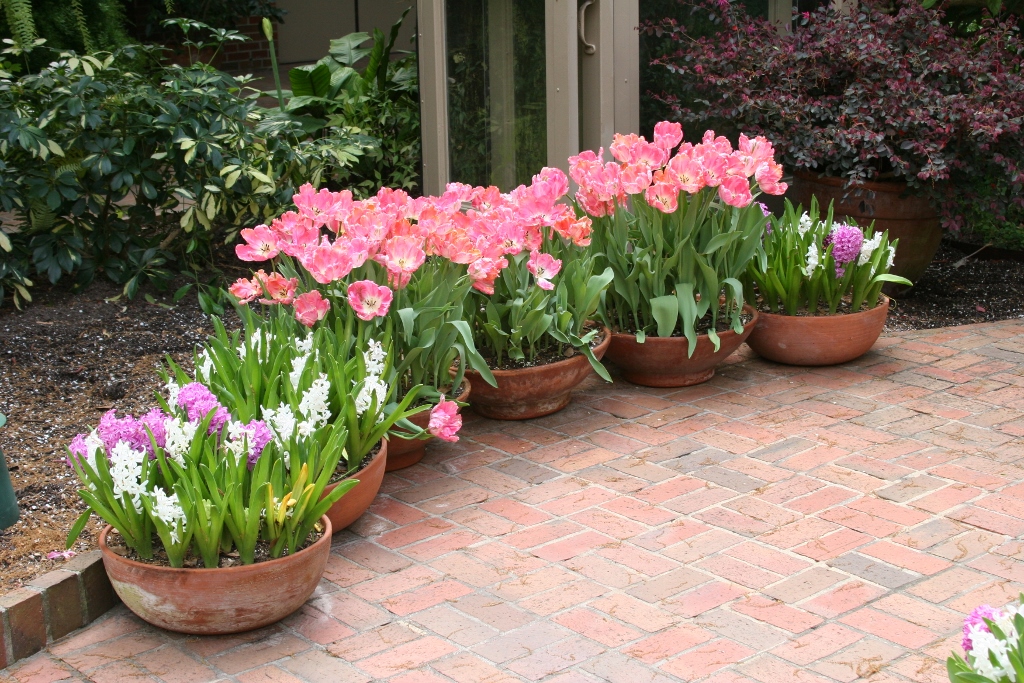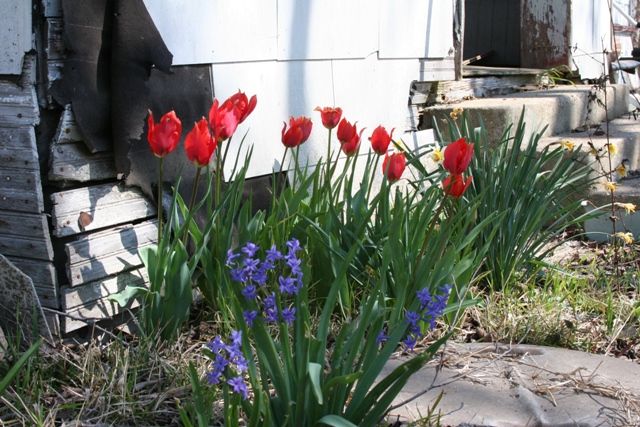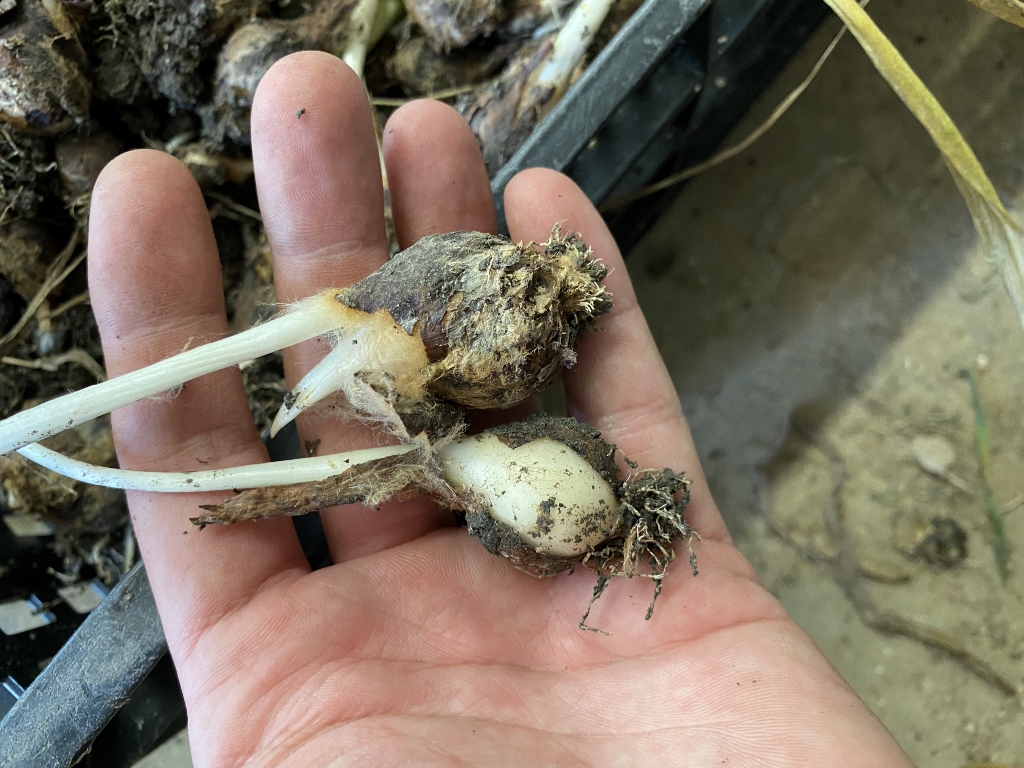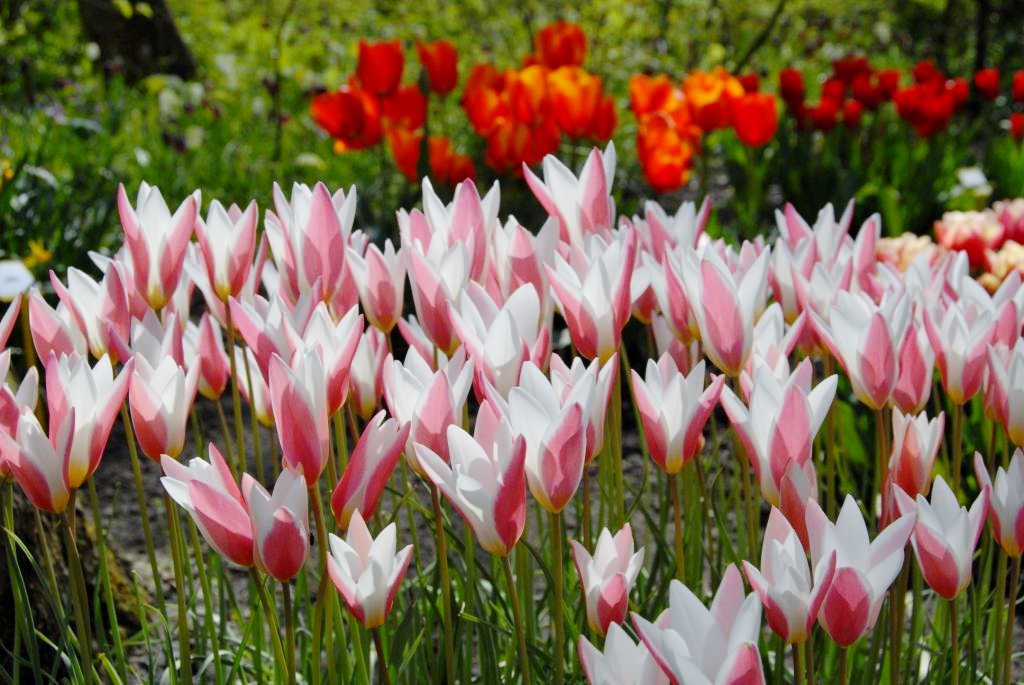Tulips!
We all love tulips! Can we grow them as perennials in warm weather climates? Yes! Can we force bloom annual tulips and enjoy them in the spring? Yes! Are ALL tulips perennials in warm climates? No.
The truth is, most folks think of the Darwin hybrid tulips with their large cups and wide variety of color selections. We see these in formal gardens, botanical gardens, or occasionally in home gardens. The blooms are spectacular, but those bulbs are pulled up and thrown away each year. There is a place for those tulips in our gardening lives, just like there is a place for pansies and other "color" plants that we change out each year. We appreciate those tulips and even offer a few selections for sell.

We also focus on perennial tulips. Yes, there are tulips that are perennials in warmer climates. The heat is not what kills tulips in the summer time. Normally, either the moisture causes tulips to rot or the varmints eat them (they are VERY tasty bulbs to animals). So, the key to perennial tulip success lies in 1) the proper selection of bulbs and 2) planting those bulbs in elevated areas that drain well and are high in clay/rock content (i.e. varmints can't dig their way or tunnel their way to them).

The proper selection of bulbs generally includes more species selections, such as Tulipa clusiana or Tulipa praecox. The naturally occurring soil conditions for perennial tulip success are typically the prairie backland clay soils, like the types we find in Waco down to Austin or in parts of Mississippi. These were traditionally great cotton growing soils. Have fun browsing our selections, and make sure you note the difference between annuals and perennials in our descriptions. If you have any questions, don't hesitate to call us at 888-285-2486 or email at info@southernbulbs.com!
Understanding Tulips and The Southern Bulb Company
I think this section might be better in the form of a conversation! Here is how it normally goes:
"Oh you have a flower bulb farm! I thought you meant light bulbs!" says the Potential Gardener (PG).
"Nope, like the plants," I respond.
"So you grow tulips?"- PG.
"Well, not really, more like daffodils, red spider lilies, some gladioli, rain lilies, and crinums."
[Insert blank stare at me as the conversation starts to die at this point]
I revive the conversation. "But I LOVE tulips. They just need a little more care and many of them are annuals.There is a special red tulip that we sometimes carry that is a perennial found on old home sites, but that is a longer story."

If the Potential Gardener is engaged, then the following questions usually begin:
Do I need to refrigerate tulips? Not species tulips like the majority of our offerings, but yes on many of the large flowering types. [Read below on "chilling tulips]
Are tulips perennials for warm climates? Typically, no, although the Tulipa clusiana selections come back for us every year when we plant them in areas that are not under irrigation and the soil drains well.
Do you like annual tulips? Yes, because I treat them like pansies, snapdragons, marigolds, zinnias, and other annuals that I change out every year.
Isn't that exhausting? I keep them limited to a small area where I can change them out with only a couple of hours of work. The spring show is worth it.
I thought you only did perennial heirloom bulbs. Well, that is our main focus, but our gardens also have trees, shrubs, grass, annuals, and other flowers. Plus working with annual bulbs is an easy companion to the many perennial flower bulbs in my garden.
More Tulip Gardening Tips
SOIL: Some tulips naturalize more than others specifically in regards to the Lilac Wonder and the Lady Jane. Many of these small tulips would be perennials IF they are allowed to be in completely dry conditions in the summer. Often, sandy loam soil will not allow tulips to be perennials in our humid South because they can not get dry enough in that soil. The tulips need rocky almost 'baked' soil in the summer. If your soil isn't like that, you can create your own if you elevate the bulbs and make sure they are completely dried out during the summer months.
Making them Bloom: Tulips are the most thought-of bulb in the world. Thus, it is natural that we receive a lot of questions about tulips for warmer climates. The tulips that we see in garden catalogs are often Dutch hybrid tulips that require a certain number of chilling hours to bloom. Usually, those bulbs need about 2,000 “chilling hours” which is loosely defined as the number of hours the bulb is exposed to temperatures less than 45 degrees. This is why many people are told to refrigerate their bulbs for 8 to 12 weeks in warmer climates before planting them in the ground in the late fall. However, many tulips don’t have such chilling requirements. This is especially true of the many of the species tulips and their immediate hybrids. These are the types of bulbs that we focus on selling at The Southern Bulb Company. They can be planted and will bloom reliably without such chilling hours or needs of artificial refrigeration.
This then begs the question, “Will they survive in our heat?” The short answer is yes! Many tulips come from hot places in the world. What causes most tulips to die in places like Texas and the south, is the wet conditions and humidity of soils. The bulbs simply rot in the summertime. Therefore, to overcome this, we often suggest planting tulips in areas with well-drained soil that will dry out in the summertime.

Other Pests: Be careful of pocket gophers and other rodents that love to eat tulips in the summertime. We once lost over 1,000 bulbs of our “Texas Tulips” in about 2 weeks due to these rodents (just like our Byzantine glads which are still being offered at their great price this fall). They love sandy loam well drained soils. Plant tulips in the fall at a depth of 2-3 times the height of the bulb.
Planting: We suggest planting 3-5 bulbs per hole for an immediate display of color that next spring. Let the foliage die down naturally in the spring after the bloom. This dying foliage is the highway that transports the food to the bulb for storage during the long dormant summer months. If planted in the right location, there is no need to dig, divide, store, or chill your tulips. Leave them in the ground so they can propagate and fill your garden as a beautiful perennial.

